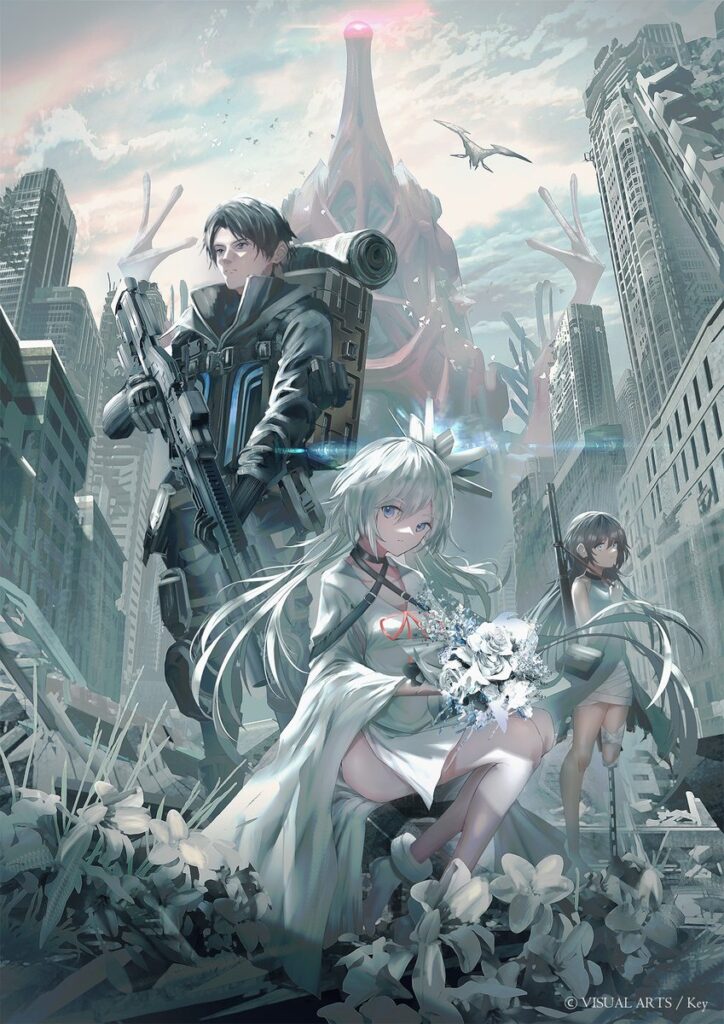
As of mid-2024, a good majority of the games Key/Visual Arts have put out are legally available in English, with the exceptions of Air, Kud Wafter, their Prima Doll kinetic novels, the Rewrite fan disc, and Summer Pockets: Reflection Blue. Before 2015, it was nigh impossible to procure their games outside of fan translations, but now almost their entire library is available. Hell, just a few months ago, their first visual novel, Kanon, FINALLY got an official English translation and release in the US, 25 years after its 1999 release. Now that I’ve played a good majority of their games—mainly their kinetic novels—and seen anime adaptations of the ones I haven’t played, I’ve gotten a bit familiar with their formula. I like the anime adaptations of Air, Kanon, and Clannad, but haven’t played the VNs for Air and Clannad yet. The game version of Air, while an important piece of Key’s legacy, has a lot of problematic aspects that really did not age well; Harmonia is fairly good but a big chunk of its lore doesn’t make sense, Loopers suffers from not doing enough with both its large cast of characters and premise, and while I enjoyed Lunaria: Virtualized Moonchild, it only started getting good in the second half, and the first half of the game is a bit of a climb. I have mixed feelings on the games of theirs that I have played, but that’s not to say I hated them. There are two that I genuinely enjoyed without any reservations: Planetarian, their first kinetic novel, and the subject of today’s review, Stella of the End.
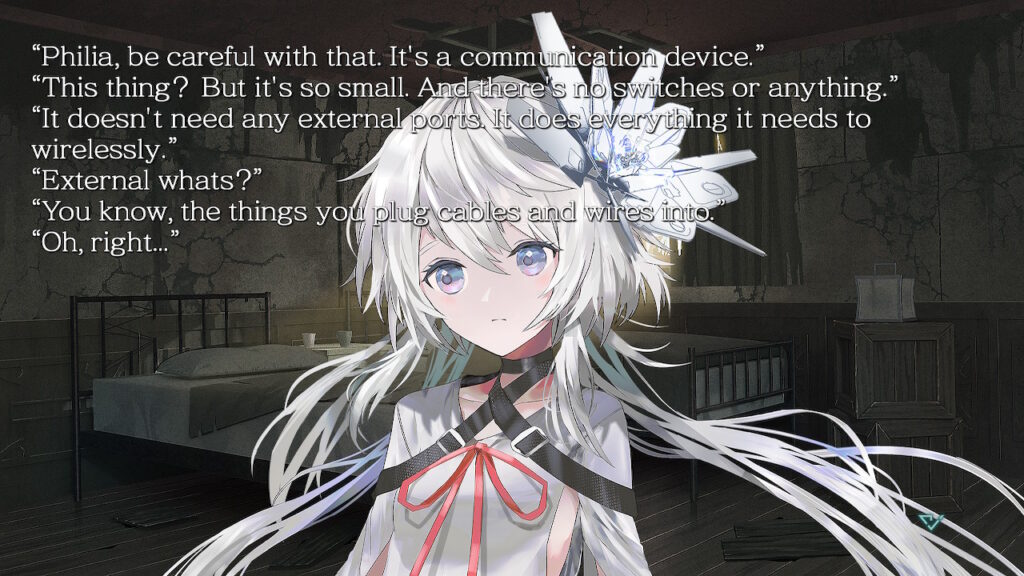
The story goes as follows: The world has been almost completely decimated by gigantic automatons known as Singularity Machines, to the point where humanity is on the brink of extinction. Jude Gray is a stoic, disillusioned man who works as a courier, traversing the dangerous wilds in search of whatever items or treasures he can deliver to high paying clients. One day, he receives a job offer from an old man calling himself Duke Willem Grosvenor. Willem wants Jude to deliver some cargo for him, but it’s not just any cargo. Willem claims this cargo can help him save humanity. After some convincing, Jude accepts the job offer and goes into some ruins to find the cargo Willem wants. What he finds is not what he expects: An android made to resemble a young girl, and when she awakes, the first thing she mentions is that she wishes to become human. Put off by how life-like she is considering her nature as a machine and her childish, idealistic personality, Jude gives her the name Philia. Faced with no choice but to deliver her to her intended destination, Jude and Philia must traverse the hostile wilderness together, avoiding threats both mechanical and human. What awaits Jude and Philia at the end of the road? Can humanity really be saved, or is it already too late…?
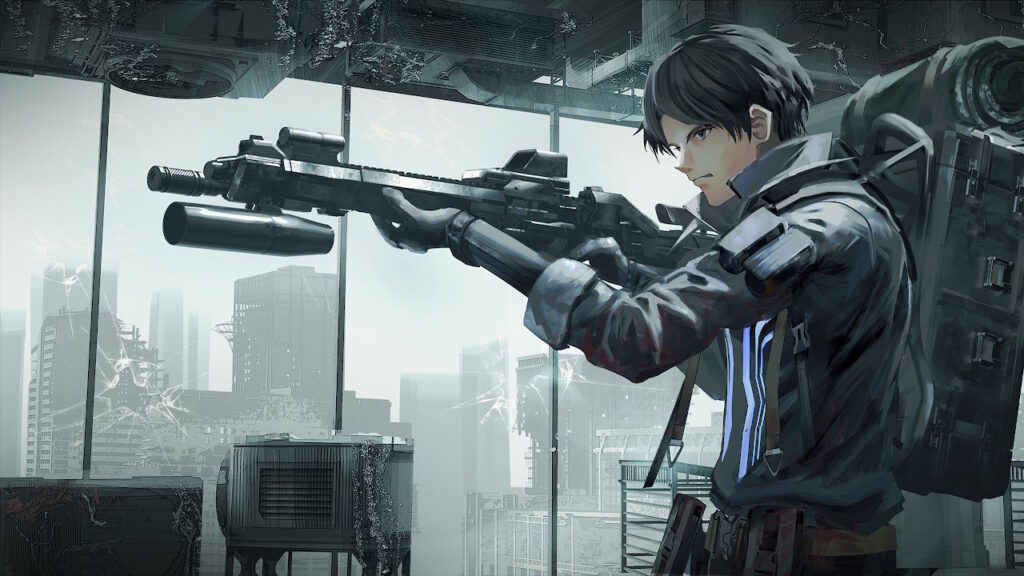
I’m going to make a bold statement here, and I know not everyone is going to agree with me, and that’s fine. But in my opinion, Stella of the End is Key’s best kinetic novel. At least, out of the games of theirs that I’ve played. One of the reasons I feel this is the case is that Stella of the End really goes against Key’s usual formula. Sure, you have the disillusioned, stoic male protagonist and a younger, cuter female co-star, with the game focusing on their interactions and fleshing them out as the story goes on. Key has always made it a point to have their games focus on small scale, character driven dramas, but one of the things I find that I don’t like is that they have a tendency to shoehorn in really cringy, problematic, out of place humor that would either ruin the mood of a scene or just feel unnecessary, to the point where you could cut it out and nothing would be lost. I discovered this recently in the VN for Air, where there were more than a few scenes involving characters groping other girls’ breasts, even among family members! Did we really need that? Or Summer Pockets’ whole running gag about it’s MC constantly walking in on one girl changing her clothes almost every time they see each other. Being a much smaller game with a tighter focus on its narrative and a very miniscule cast of characters, none of that is present in Stella of the End, and whatever moments of levity in the game are not only much fewer, but hit the mark much better in that its moments of comedy never goes for the lowest common denominator, and make sense for the characters.
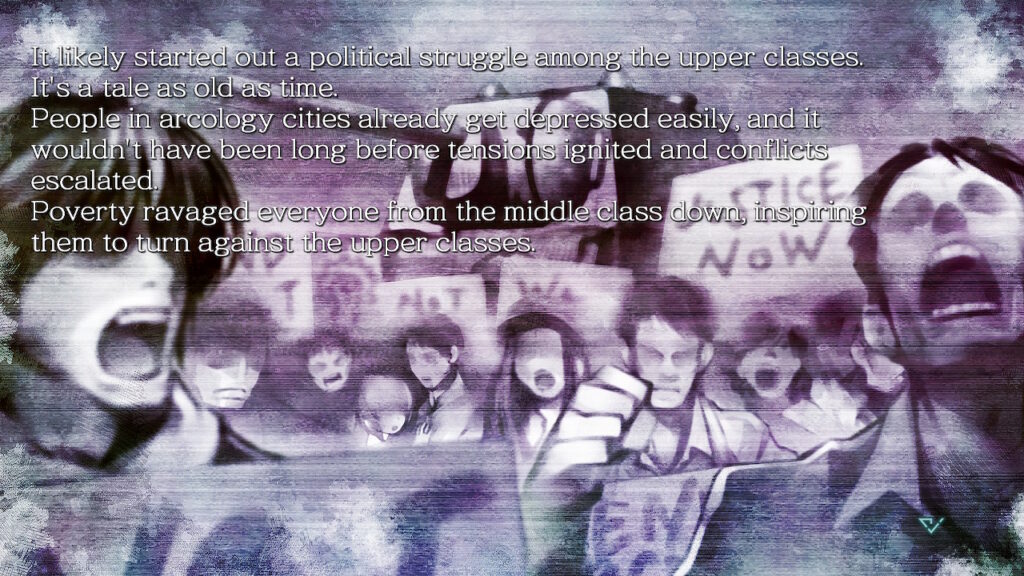
Furthermore, compared to previous kinetic novels like Planetarian and Harmonia, Stella of the End is much darker in its themes and atmosphere. The story does a great job in selling just how desolate and decimated this world is through both its lush, gorgeous artwork courtesy of artist SWAV and how the various people Jude and Philia encounter throughout their journey cope with their unique situations. If I were to make a comparison, I’d compare Stella of the End to Girls’ Last Tour, as both stories are focused on how their respective pairs of MCs navigate the world around them and make the most of the situations they’re in. Granted, Stella has much higher stakes, is more violent and bleak, and has a more concrete goal compared to GLT, but they still prove that apocalypse stories don’t always have to be just explosions and constant misery all the time.
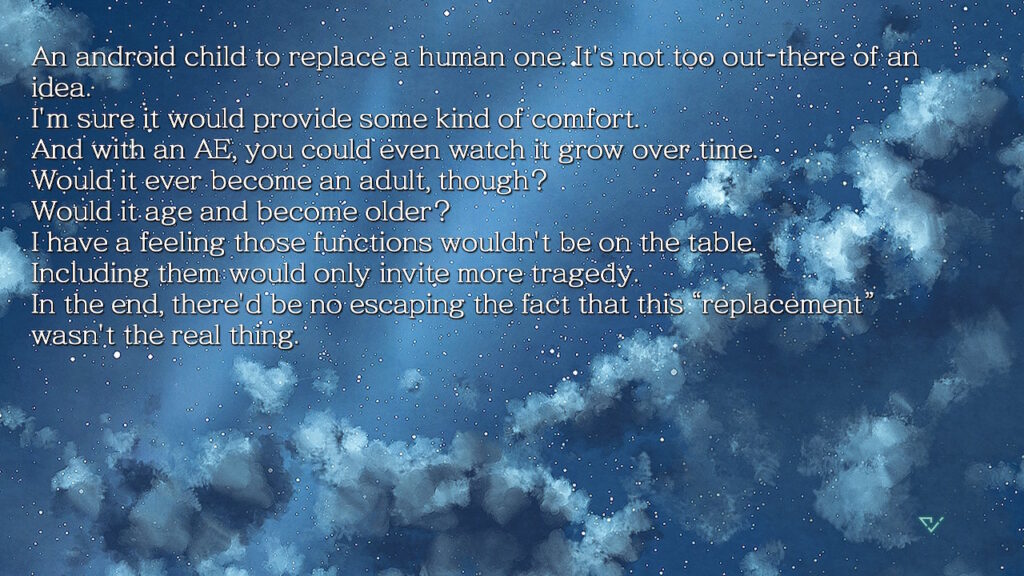
Speaking of artwork, I really need to talk about the backgrounds because they are just utterly gorgeous. You could frame every single one of them and hang them up on the wall, they’re that amazing! Hell, the game is aware of this and has a gallery specifically for the backgrounds! The CGs and character designs are both great in their own right, and I really appreciate that Jude actually looks and acts like a rugged, ragged adult man as opposed to an adult man who just looks like a baby-faced teenager. The mech designs are also really good too, and wouldn’t feel out of place in something like Planetarian or even a Gundam series.
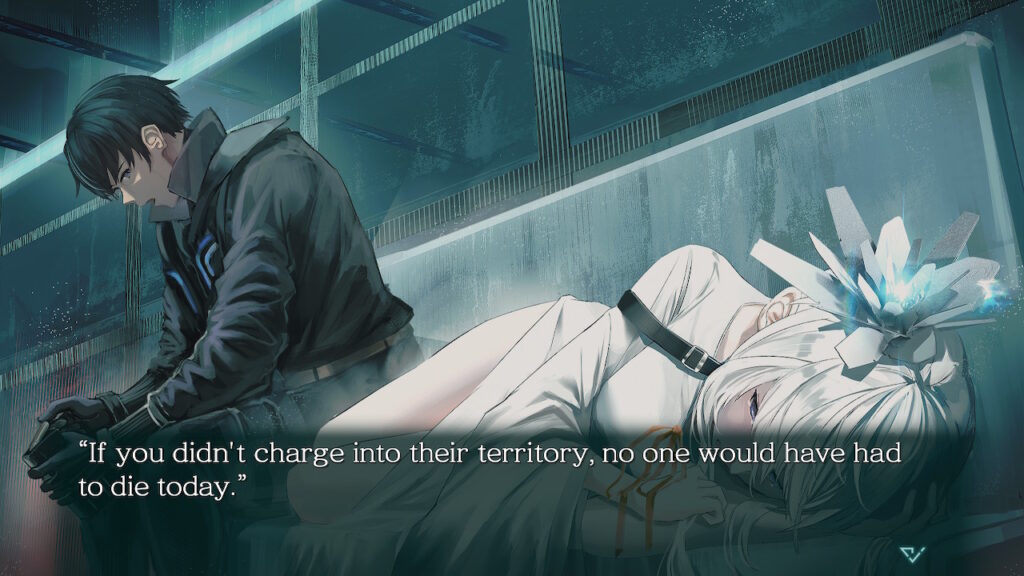
Of course, the real backbone of Stella of the End is its main pair of characters. Now, Key has used these particular archetypes multiple times throughout their games, but here, the entire game is taken up by Jude and Philia, with very few side characters. As far as their development goes, Key really knocked it out of the park, as Jude and Philia, while starting out like rote stereotypes, really grow and come into their own throughout the game, especially near the end, becoming wonderfully evolved characters with plenty of strengths and flaws to carry the game perfectly. Jude in particular is especially well developed, a man who is inured by his circumstances and haunted by the decisions he was forced to make throughout his life. That said, your enjoyment of the game will depend on how much you can stomach Philia. She’s your typical cutesy moe Key girl at first; benevolent, childish, naive, and meant to endear the audience with her cutesiness, and it takes quite a while for her to really grow past her early character flaws. I personally had no problem with her, as the game does call her out whenever she causes problems for Jude, with one particular chapter being really brutal in how it does so, and I’ve seen far worse characters who not only don’t learn from their mistakes but are worshipped like hell in the series they originate from. But I can see plenty of people not being too fond of Philia for those same reasons, especially with how long it takes for her to finally grow a spine and stop acting like a pampered princess.
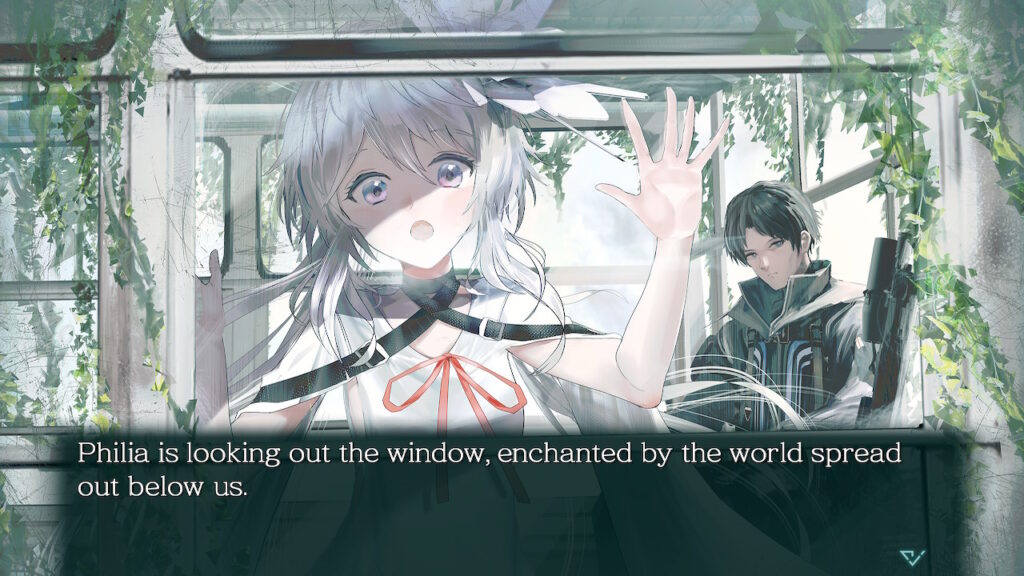
I will admit, there are a few things about Stella of the End that do hold it back from true greatness in my opinion, and are really more personal preference than anything. For one, I really don’t like the dialogue interface in this game. It just looks weird having this ugly green filter cover the entire screen while the characters are talking. When it comes to visual novels, or whatever games utilize them in general, I prefer the usual dialogue boxes that just stay at the bottom of the screen, or the occasional stylistic choice, over having it take up the entire screen and covering the beautiful visuals. I know the original version of Harmonia had this issue in the original PC release, but at least there, they put dialogue boxes on the side of the screen as opposed to having it take up all of it, and later changed this in the Switch re-release. Granted, Stella does allow you to reduce the opacity to basically nothing, getting rid of the green filter, but unless you have the game covering your entire computer screen, it presents another problem in that the text becomes hard to read, especially against bright or white backgrounds. Luckily, the Switch version adds dialogue boxes at the bottom of the screen, remedying this somewhat, only limiting the whole-screen dialogue segments for certain scenes, so I’ll give it points for that. Also, while I do feel Stella of the End has the best worldbuilding and lore out of all their kinetic novels, it does have the same problem as their other games in that not a lot of said lore makes sense if you think about it and really relies on you stretching your sense of disbelief quite a bit. The actual story reveals were interesting, but I do wish more had been done with them, especially in regards to how sentient AIs work, and a few little things scattered throughout the game don’t get any explanations behind them.
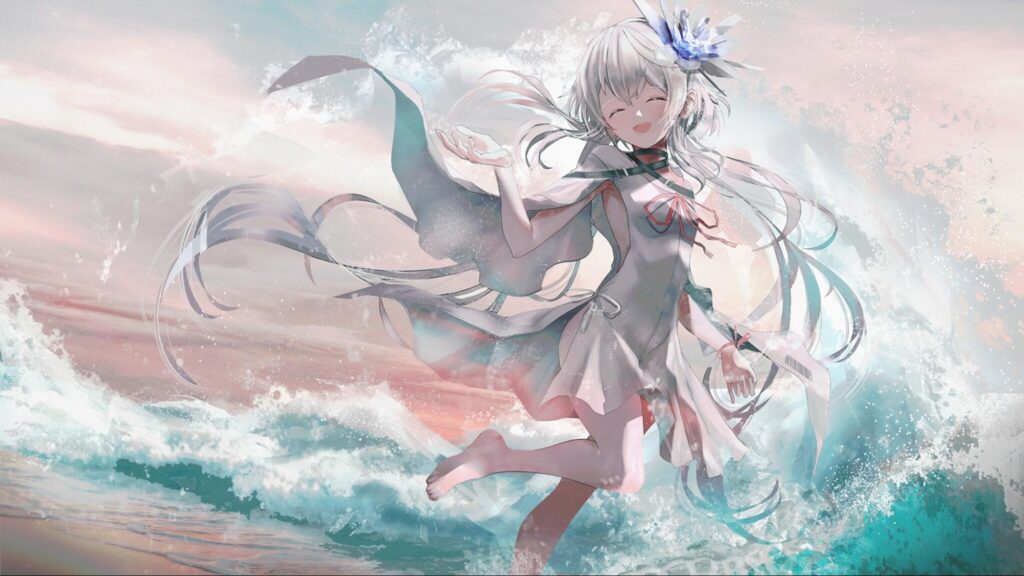
But Stella of the End isn’t interested in exploring the ethics of AI or doing a deep dive into robots and how they work, it’s all about the journey Jude and Philia go on, seeing the world’s beauty and ugliness and making the most of the time they have together even as the odds seem stacked against them. Oh, and for anyone wondering, there’s no romance in this game at all, so don’t worry, Jude and Philia don’t get together romantically. Considering how childlike Philia is and the fact that Jude is an adult, that’d just be creepy, and I’m glad Key didn’t go that route here. Stella of the End is what I wish Atri: My Dear Moments could have been had it just cut out the filler and focused on fleshing out its characters and plot. Key really took their experience doing stories like this and put it to good use here, and in my opinion, Stella of the End is the best kinetic novel they’ve made. So yeah, if you want a good sci-fi found family story that doesn’t overwhelm you with technobabble and cares about its story and characters, give Stella of the End a shot.

Aww crap, I meant to say “haven’t played the VN for Clannad yet” as opposed to “haven’t played the VNs for Air and Clannad yet” since I have played the Air VN, even reviewed it on here. Note to self, check these things before sending your reviews off to be posted.
Thanks for posting my review!
No worries, happens to the best of us! It’s easy to get mixed up when you’re reviewing multiple VNs. At least you’ve got Clannad still waiting for you—such a classic, so it’ll be worth the wait! And no problem, your review was great and definitely deserves the spotlight! I’m sure the community will enjoy hearing your thoughts on it too. Looking forward to hearing what you think of Clannad once you dive into it latest anime